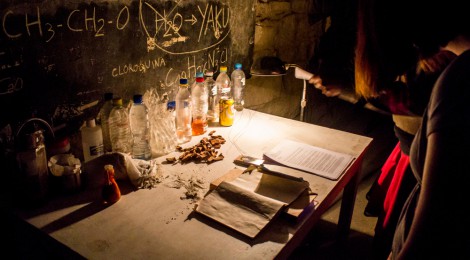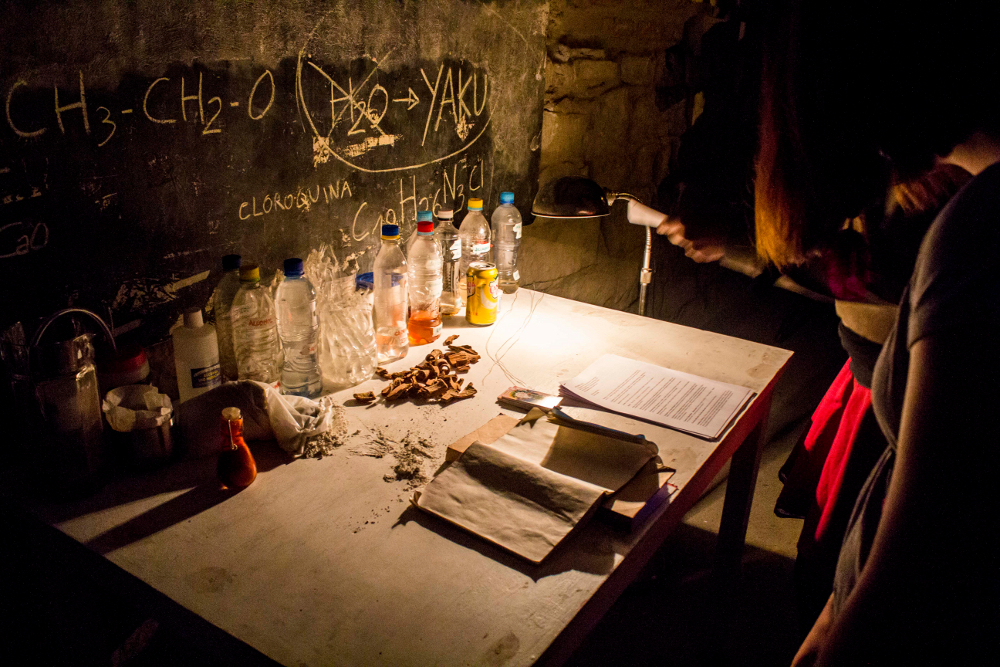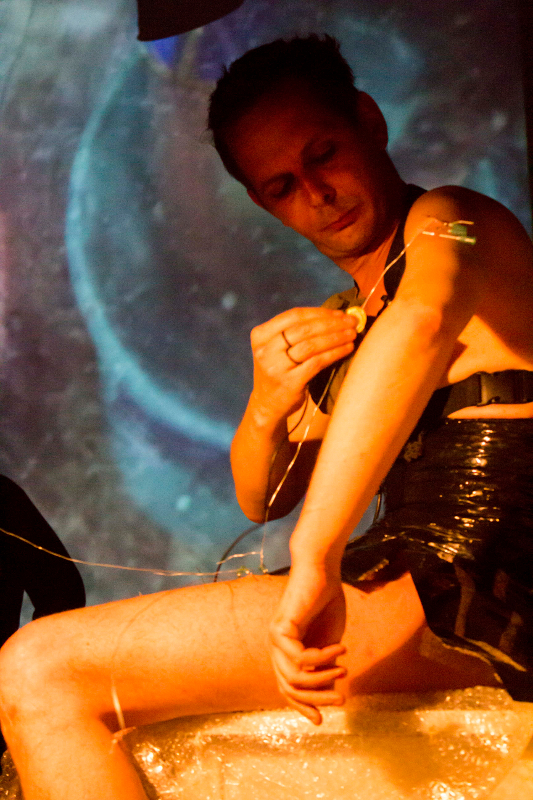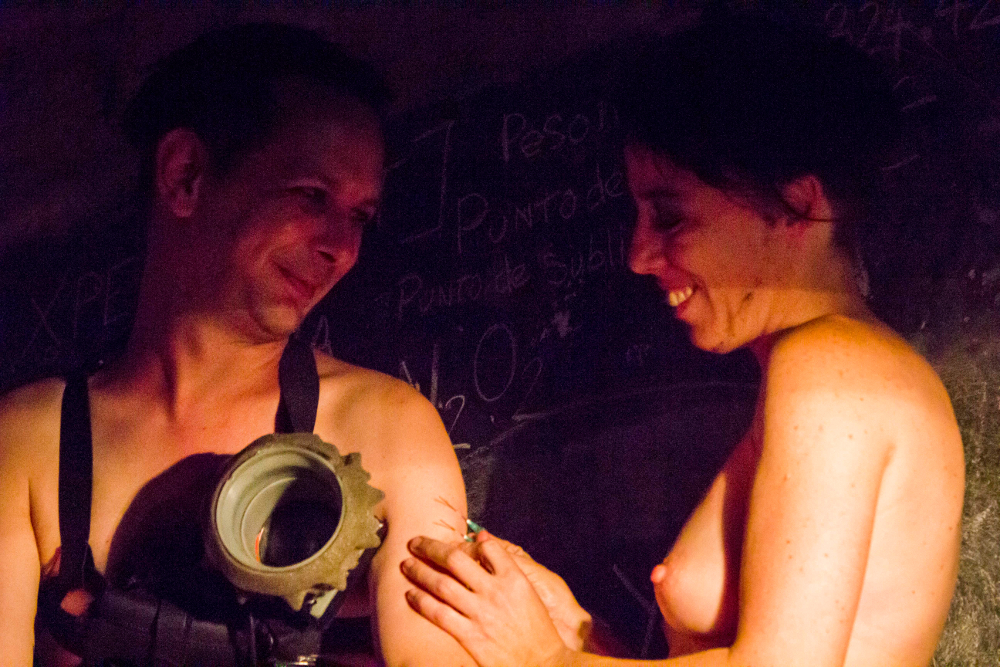
Akelarre Yaku
This performance is the outcome of residence in mARTAdero, Cochabamba. Bolivia. With Maria F Dolores of Transnoise in october/november 2012.
Project
|Conceptual Report| > Performance/Coven /Witchcraft
The covens were gatherings between witches. If we aloud us to dissociate them from the religious definitions of witchcraft, as well as the socio- historical readings, we find a set of practices that, through the manipulation of symbols, bodies, objects, signs and surroundings, aim at the creation / modification of the world. Approaching from a queer / feminist perspective, the claims of the latest artistic vanguards to remove the border between art and life, we can consider the covens as collective art performances. All the practices of witches, which themselves named as “the arts” or “art” today need a multitude of categories so as to be addressed, such as art, politics, philosophy, technique, science, sexuality.
The idea of the coven (akelarre) applied to the performance is dissociated from any concept of representation or theatrical practices. The akelarre is not a demonstration of what the witches are, either is the place where the participants pretend to be witches. The akelarre is becoming-witch (Devenir).
The main performative guidelines of [AKLR 2.0] are :
The structure of the performance is not based on repeated phrases marked as a choreography. Every meeting/ rehearsal will be based on prior patterns (rituals), taken as the medium through which we will approach the variables of the context.
The movement of the bodies will not be based on esthetic parameters but on the concept of the hybrid mutation of body/machine, body/surroundings. The performance activity will be worked in terms of symbiotic movements, so as to permit the non- separation of subjectivities and surrounding.
In each essay/ attempt the rituals will be modified by the context. The series of essays generate a cumulus of experiences (practices, tools, knowledge, relationships) that should permit the phenomenon of an akelarre, which we understand as the manifestation of a realized mutation on the participants and their environment.
> Performance/Akelarre Yaku/Reductos Tecno-Lógicos/Cochabamba
Declining of the definitions that entail witchcraft to esotericism , (…), [AKLR 2.0] wants to re appropriate the concept of witchcraft. We believe that behind the persecution of witchcraft has been a desire of socio-cultural homogenization, structured around parameters such as gender, race and class. We consider that the people and communities targeted by this process of normalization, had (and still own) a set of knowledges and practices that enables them to create and transform the reality.
In the case of our proposal in response to the mARTadero call, on Reductos Tecno-Lógicos (techno-logical holdouts) we thought focusing on the water element because of its importance in Cochabamba. We feel that we have a lot to learn by the “guerra del agua” (water war) in terms of experience, where a mixture of social mobilizations and sets of conceptual creations and ritualized practices around an element (H20), presented by one side as a mere resource management, has allowed a social transformation.
To this end we would like, during our residency, to register local experiences around water, the rituals involved and symbolisms, same as experiences and points of view on the “guerra del agua” (water war). The tools used will be video documentation, photography, sound recording, drawings, compilation of newspaper articles. The purpose is not “document on” but generate exchanges of knowledge and practices so as to integrate this process into the performance.
Far from an exotic approach towards this concepts and rituals,we are planing to re-interpret and give them back, transformed by a process of remixing. It is not an exercise of mimesis (which can only impoverish the imitated) but one of collective creation and exchange. A process in which the creation is considered remixing, where The created is result of the hybridization of visions and where the work is returned to the public domain, hoping to achieve the desired change.
An artwork where the concept of Free Culture is like the ritual of Yaku-Change: “During the ritual, the dancers mingle and exchange their parts of water, then they spread them on the ground. Water is circulated through the community assembly in a manner analogous to the continuous circulation that the element maintains in the natural environment. Through this process, is made a symbolic recreation of the community and is hoped to achieve the desired change in the climate “(Sikkink, 1997).
KININA EXPERIMENT
We integrated collective rituals around the element of water. The performance includes records out of local experiences, rituals and symbols. Nevertheless is not resuming these concepts and rituals from an “exotic” perpective, but re-interpret them so as to be returned, changed by a process of remixing. It is not a mimetic exercise (which can only impoverish the imitated) but a collective creation and exchange.
Serendipity: Water, fluorescent liquids, Quinine. A research that led us to colonization and its links with the witch hunt.
Below the text result of research and shared at the performance
[Kinina Xperiment]
Quinine : Its systematic name (IUPAC ) is ( 6-methoxy- quinolin -4 – yl ) – 5 ( vinyl-1 – aza – bicyclo [ 2.2.2 ] oct -2 – yl) – methanol ( C20H24N2O2 ). Its molecular mass is 324.5 amu and its melting point of 175 ° C.
Quinine is an organic analgesic alkaloid, white, crystalline, with antipyretic properties, anti- malarial, produced by a species of the genus Cinchona. It has a very bitter taste.
Quinine derives from Quina.
Quina: Bark of Cinchona, a tree native to the forests of Ecuador, Peru and Bolivia.
Quina: ” Kina Kina ” in Quechua, the “Bark of Barks “.
Kina: Substance used by Andean witches as a remedy for fever, muscle aches, and as an abortifacient.
Quina: Substance discovered by Spanish colonists.
Officially, by Pizarro in 1559, who heard about the wonders that Andean witches did with it and the potential that this knowledge represented, considering their previous zero knowledge on the subject.
Discovery: Results of a double crossover process of cultural, social and political normalization inside and outside European territory: colonization and witch hunt.
Discovery: Formalization of, the appropriated by the colonial power, knowledge that was stolen during this period.
Colonization and Witch Hunt:
Process in which occurs the transition between the Middle Ages and Modernity in Europe,
or to put it another way between feudalism and the Modern Liberal State.
Colonization and Witch Hunt:
appropriation of land , substances and knowledge.
Cultural normalization based on private ownership of lands, substances and knowledge. Extermination of people, communities, cultures and non-normative practices.
Production of new subjectivities , knowledge and regulated practices.
Transition Medieval Age – Modernity :
The process that created and produced the ” Disciplinary Power” defined by Foucault as ” the passage of the Law (discipline) to the Normalization (Bio-politics).”
Cinchona officinalis Cinchona officinalis : Scientific name of Quina tree.
Countess of Chinchon: First European officially cured of malaria by Kina.
In 1638 , in Lima, against the inability of European doctors to cure his wife , the viceroy of Peru, Count of Chinchon , decided to use the same treatment against fever as used by andinean witches, a decoction of kina powder.
The treatment was successful and from that moment ” Countess powder” ( the kina powder) were sold at a high price, and its increasingly large demand led to an increasingly intense exploitation of the cortex, resulting to its near extinction.
In 1639 was introduced in Spain.
Malaria: Royal Spanish Discovery. The disease did not exist in America, and therefore the Kina was not used as a remedy against it.
Quina: The Kina was until less than a century the only anti- malarial treatment. Still at present, different alkaloids and its derivatives remain one of the main treatments used against malaria.
Malaria: Malaria ( the medieval Italian bad aria, ” bad air “) or malaria (Latin palus , “swamp” ) is a disease caused by parasites of the genus Plasmodium. It is the first disease in importance from debilitating diseases. Between 700,000 and 2.7 million people die each year from malaria, of which over 75% are children in endemic areas of Africa . Treatments derived from Kina, are all under Western pharmaceutical patents .
[ Kinina Xperiment ] : Is a reversed engineering experiment, transforms a scientific experiment into an artistic experiment, while looking through the failures. Asking: How come a growing area that was the richest quinine assortment has become scarce in kina, quinine and derivatives?
Cochabamba, Bolivia: Area where grew Kina ledgeriana – the type of quina with the highest percentage of Quinine.
Quinine: It is extracted from the cinchona tree when the tree is about 15 years old.
The technique usually used is to hit the tree until the bark is loose, pull it and dry it. According to the tradition, infusions are prepared out of the dried bark.
Quinine: In 1820, two French scientists, Pelletier and Caventou, isolated a quinoline alkaloid of the bark, that named Quinine and which provided the highest antimalarial effect by the time. Once discovered, methods were developed to extract quinine from the bark so as to sell it as an antimalarial drug. Up to half of the nineteenth century the only source of Quina were the Andean forests.
[ Kinina Xperiment ]: Step 1. Obtain Quinine from decoction by mashing the bark of Kina. (experiments in water and ethanol).
The only kind of Quinine found at the market of la Cancha (Cochabamba, Bolvia): the Calisaya variety.
We have not managed to find it in the form of powder.
Outcome: impossible to isolate the Quinine.
By studying the chemical requirements, we realized that as any alkaloid, needed to carry out a two-stage extraction in a soxhlet.
Initially with ethanol and calcium oxide ( lime ) and then with sodium hydroxide (caustic soda). We built a homemade tatty soxhlet , and began the first phase.
At the end of this phase we had a glimpse of a (small) chance of getting some traces of quinine salts , a week later. But due to lack of time and difficulty in obtaining caustic soda (also used for the extraction of coca alkaloids such as cocaine) we proceed at Step 2.
Calisaya and pubescens : Varieties of Kina. At mid-nineteenth century, seeds of Cinchona pubescens and Cinchona Calisaya were smuggled by British and Dutch.
Calisaya species were planted and grown in Java by the Dutch and Pubescens in India and at Ceylon by the British.
However, the content of quinine of these species was very low to the high costs of actual production of quinine. Then the Dutch smuggled Cinchona Ledgeriana seeds from Bolivia and established extensive plantations of high level of Cinchona in Java, that soon dominated the world production of Cinchona and Quinine. In 1918, the production of quinine is under the total control of the Dutch firm ” Kina Burea ” in Amsterdam. It is the birth of the pharmaceutical industry. All of them reaped great benefits, but Peru and Bolivia, where all originated, never got any benefit.
[ Kinina Xperiment ] : mARTadero has no blacklight. Fer1 tells us it may be a good opportunity to buy some for mARTadero2, maybe 3 or 4. So, we went to buy them, but when we saw the price ( 190 bolivianos) we decided to buy just one. So we ended up stressed to get quinine so as to be able to justify this expense..!
Fluorescence : Fluorescence is a particular type of luminescence, which characterizes the substances capable of absorbing energy in the form of electromagnetic radiation and then emit part of that energy as electromagnetic radiation in a different wavelength.
Generally fluorescent substances absorb energy in the form of short wave electromagnetic radiation ( e.g. gamma radiation, x -rays, UV, blue light, etc. ), and then emit a longer wavelength, within the visible range. The most striking examples of fluorescence occur when the absorbed light is in the ultraviolet range of the human eye – unseen – spectrum and the emitted light is in the visible region. The typical fluorescence mechanism involves three sequential steps, respectively called absorption, emission and non-radiative dissipation. The entire cycle is very short, takes place in times of the order of nanoseconds, so it can be considered almost instantaneous. Substances that are able to emit light when excited by different types of radiation are called fluorophores. Is possible to obtain a wide variety of colors by fluorescence, depending on the emitted wavelength of the fluorescent compound.
Water : ” Agua from the Latin aqua, water is a substance whose molecules are composed of one oxygen atom and two hydrogen atoms. It is odorless, tasteless and colorless.” Classic school definition. Crap …
[ Kinina Xperiment ] : Barcelona. To test the effect of quinine, we bought a bottle of tonic water , and played with it under black light ( UV lamp that emits electromagnetic radiation) at Mazhouse .
Tonic Water : The tonic water or simply tonic, is a carbonated soft drink flavored with quinine. The tonic is the base of a drink invented by the British colonists. They needed a drink to assure that their imperialist purposes will not get prevented by malaria. So as to keep water fresh during long trips on boats, added to this water, alcohol, that created of gin. Hence arises one of the most consumed cocktail in the world, the Gin -Tonic.
[ Kinina Xperiment ] : Step 2 . After Step 1, we see that if we could get quinine, only if we mount a clandestine laboratory, so we have to abandon the path of kina and turn into more industrial solutions. One of these is to buy tonic. And it seemed the easiest . Big mistake. Hardly anyone had heard of this drink. Toured countless beverage stores . Nothing . Absurd Super- markets. Nothing. We put our hope in the Caracol, our fetish bar at Cochabamba (recommended by John and Dani ), which has Gin Tonic and Vodka Tonic in the menu. Result: three or four memorable drunkenness, but no tonic in sight. Finally, we got 6 cans of 33 cl, thanks to Liu, at a store lost under the midday sun and after a trip on trufi3 that let us in Beijing. Go to Step 2. We got yaku4 Fluor! We started with bottling. Claudia had told us, when we were still in Barcelona, that finding PET bottles would not be difficult. She was right. In three days Lesbiatán, was filled with these plastic monstrosities .
Water: El agua es nuestra! Carajo!5
Cha’ki : “Hangover” in Quechua. Wonderful fiesta of the dead in Tarata. Dennis is our guide, host and teacher of Quechua. Thank you !
[ Kinina Xperiment ] : Barcelona. Checking the blue magic of quinine under black light. Substance chosen ! We get to investigate and discover its Andean origins and history.
Pure serendipity. The aesthetic choice gets sense. And we say that once in Cocha , we wouldn’t need to buy tonic water but make infusions of Kina and get liters of fluorine yaku at as much quantity as we wish. Again, we were deeply wrong. See Step 1 and Step 2 .
Drug – Disciplinary regime : Control of pharmacology has been a central element in the witch hunt and colonization. Scientific knowledge of the modern age is the result of the appropriation of a multitude of local knowledge and its subsequent normalization under the framework of a universal and hegemonic culture.
Drug – Disciplinary regime : With the colonization of South America numerous were the pharmacological substances (and associated knowledge ) with which the Europeans left : curare , quinine , coca, coffee, kola nut, cocoa, tobacco… These substances were marketed under a near monopoly in the metropolis (with enormous gains , taxed atimportant rates that would end to the crowns ) and under a system of complete exploitation at the colonies, which promoted monoculture and its dependencies, disruption of ecosystems and slavery.
Drug – geo-strategy : In 1942 , Java was occupied by the Japanese, causing a severe shortage of quinine on the side of the Allies, and the sources of trees Chinchona at South America were once again in demand while new crops were planted in Africa. Currently Zaire, is the leading producer of quinine extracted from Kina. This lack of quinine was also the engine that fueled research to develop and produce synthetic antimalarials.
[ Kinina Xperiment ] : Step 3. Looking for Quinine Sulfate, obtained from the Quina alkaloid.
We firstly visited a couple of pharmacies. Frequent answers : ” You can not get Sulfate of Quinine from a pharmacy, is allowed only in health centers ” and ” Quinine , no! This is not possible “.So we thought on opting for the side of chemical stores . After locating the first, we proceed . Answer: ” Uuuuhhh it will not be easy finding quinine..!” in the same mode visiting dozen shops, bouncing from one to an other.
The last,” The American”, the greatest, amazing, with different sacs open throughout the store … We left there with a tremendous buzz and a new direction recommended to check out, the ” Bolivian Pharmacy “. Okay, last try. “Wait, I’ll check … ” ” No, we do not have. There is Chloroquine though, but if you prefer, on Monday our chemist could prepare some quinine sulfate for you”. We caught two tablets of chloroquine just to test, the test failed, but it didnt matter we would soon have… Sulfate !
Chloroquine : During World War II, the U.S. government sponsored a series of clinical trials on this drug to test its therapeutic value. In 1947 authorized medical use for prophylactic treatment of malaria. Chloroquine is the first synthetic anti – malarial and together with quinine is currently the most widely used for the prevention and cure.
[ Kinina Xperiment ] : Step 3. We have Sulfate of Quinine! First tests. With water and ethanol. Nothing . We review the chemistry of alkaloids. An acid is required. We look homemade recipes of tonic. Lemon. Citric acid . We try by boiling in water with lemons. It works ! We have yaku blue fluor…
Here blog of the project: travelbook & residence
Akelarre Yaku was the first version of the project Akelarre Cyborg.
This performance was presented inside the “Enredarte con NADA” festival, in november 2012























